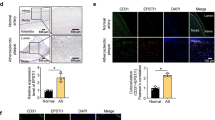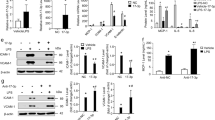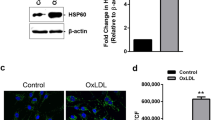Abstract
Rapamycin and its derivative possess anti-atherosclerosis activity, but its effects on adhesion molecule expression and macrophage adhesion to endothelial cells during atherosclerosis remain unclear. In this study we explored the effects of rapamycin on ox-LDL-induced adhesion molecule expression and macrophage adhesion to endothelial cells in vitro and the underlying mechanisms. Ox-LDL (6–48 μg/mL) dose-dependently increased the protein levels of two adhesion molecules, intercellular adhesion molecule-1 (ICAM-1) and E-selectin, in human umbilical vein endothelial cells (HUVECs), whereas pretreatment with rapamycin (1–10 μmol/L) dose-dependently inhibited ox-LDL-induced increase in the adhesion molecule expression and macrophage adhesion to endothelial cells. Knockdown of mTOR or rictor, rather than raptor, mimicked the effects of rapamycin. Ox-LDL (100 μg/mL) time-dependently increased PKC phosphorylation in HUVECs, which was abolished by rapamycin or rictor siRNA. Pretreatment with PKC inhibitor staurosporine significantly reduced ox-LDL-stimulated adhesion molecule expression and macrophage adhesion to endothelial cells, whereas pretreatment with PKC activator PMA/TPA attenuated the inhibitory effect of rapamycin on adhesion molecule expression. Ox-LDL (100 μg/mL) time-dependently increased c-Fos levels in HUVECs, and pretreatment with rapamycin or rictor siRNA significantly decreased expression of c-Fos. Knockdown of c-Fos antagonized ox-LDL-induced adhesion molecule expression and macrophage adhesion to endothelial cells. Our results demonstrate that rapamycin reduces ox-LDL-stimulated adhesion molecule expression and macrophage adhesion to endothelial cells by inhibiting mTORC2, but not mTORC1, and mTORC2 acts through the PKC/c-Fos signaling pathway.
Similar content being viewed by others
Log in or create a free account to read this content
Gain free access to this article, as well as selected content from this journal and more on nature.com
or
References
Libby P . Inflammation in atherosclerosis. Nature 2002; 420: 868–74.
Frostegård J, Wu R, Haegerstrand A, Patarroyo M, Lefvert AK, Nilsson J . Mononuclear leukocytes exposed to oxidized low density lipoprotein secrete a factor that stimulates endothelial cells to express adhesion molecules. Atherosclerosis 1993; 103: 213–9.
Ito F, Tatsumi H, Mori T, Suganuma I, Tanaka Y, Sasaki A, et al. Medroxyprogesterone acetate enhances monocyte-endothelial interaction under flow conditions by stimulating the expression of cell adhesion molecules. J Clin Endocrinol Metab 2014; 99: 2188–97.
Takahashi Y, Zhu H, Yoshimoto T . Essential roles of lipoxygenases in LDL oxidation and development of atherosclerosis. Antioxid Redox Signal 2005; 7: 425–31.
Guo YL, Bai R, Chen CX, Liu DQ, Liu Y, Zhang CY, et al. Role of junctional adhesion molecule-like protein in mediating monocyte transendothelial migration. Arterioscler Thromb Vasc Biol 2009; 29: 75–83.
Lewis JC, Kottle BA . Endothelial damage and thrombocyte adhesion in pigeon atherosclerosis. Science 1977; 196: 1007–9.
Shi Y, Frankel A, Radvanyi LG, Penn LZ, Miller RG, Mills GB . Rapamycin enhances apoptosis and increases sensitivity to cisplatin in vitro. Cancer Res 1995; 55: 1982–8.
Hosoi H, Dilling MB, Liu LN, Danks MK, Shikata T, Sekulic A, et al. Studies on the mechanism of resistance to rapamycin in human cancer cells. Mol Pharmacol 1998; 54: 815–24.
Sousa JE, Costa MA, Abizaid A, Sousa AG, Feres F, Mattos LA, et al. Sirolimus-eluting stent for the treatment of in-stent restenosis: a quantitative coronary angiography and three-dimensional intravascular ultrasound study. Circulation 2003; 107: 24–7.
Morice MC, Serruyys PW, Sousa JE, Fajadet J, Ban HE, Perrin M, et al. A randomized comparison of a sirolimus-eluting stent with a standard stent for coronary revascularization. N Engl J Med 2002; 346: 1773–80.
Hausleiter J, Kastrati A, Mehilli J, Vogeser M, Zohlnhöfer D, Schühlen H, et al. OSIRIS Investigators. Randomized, double-blind, placebo-controlled trial of oral sirolimus for restenosis prevention in patients with in-stent restenosis: the oral sirolimus to inhibit recurrent in-stent stenosis (OSIRIS) trial. Circulation 2004; 110: 790–5.
Sehgal SN, Molnar-Kimber K, Ocain TD, Weichman BM . Rapamycin: a novel immunosuppressive macrolide. Med Res Rev 1994; 14: 1–22.
Laplante M, Sabatini DM . mTOR signaling in growth control and disease. Cell 2012; 149: 274–93.
Loewith R, Jacinto E, Wullschleger S, Lorberg A, Crespo JL, Bonenfant D, et al. Two mTOR complexes, only one of which is rapamycin sensitive, have distinct roles in cell growth control. Mol Cell 2002; 10: 457–68.
Kim D, Sarbassov D, Ali S., King J, Latek R, Erdjument Bromage H, et al. mTOR interacts with raptor to form a nutrient-sensitive complex that signals to the cell growth machinery. Cell 2002; 110: 163–75.
Hara K, Maruki Y, Long X, Yoshino K, Oshiro N, Hidayat S, et al. Raptor, a binding partner of target of rapamycin (TOR), mediates TOR action. Cell 2002; 110: 177–89.
Vander Haar E, Lee SI, Bandhakavi S, Griffi TJ, Kim DH . Insulin signalling to mTOR mediated by the Akt/PKB substrate PRAS40. Nat Cell Biol 2007; 9: 316–23.
Sancak Y, Thoreen CC, Peterson TR, Lindquist RA, Kang SA, Spooner E, et al. PRAS40 is an insulin-regulated inhibitor of the mTORC1 protein kinase. Mol Cell 2007; 25: 903–15.
Kim DH, Sarbassov DD, Ali SM, Latek RR, Guntur KV, Erdjument-Bromage H, et al. GbetaL, a positive regulator of the rapamycin-sensitive pathway required for the nutrient-sensitive interaction between raptor and mTOR. Mol Cell 2003; 11: 895–904.
Sarbassov DD, Ali SM, Kim DH, Guertin DA, Latek RR, Erdjument-Bromage H, et al. Rictor, a novel binding partner of mTOR, defies a rapamycin-insensitive and raptor-independent pathway that regulates the cytoskeleton. Curr Biol 2004; 14: 1296–302.
Jacinto E, Loewith R, Schmidt A, Lin S, Ruegg MA, Hall A, et al. Mammalian TOR complex 2 controls the actin cytoskeleton and is rapamycin insensitive. Nat Cell Biol 2004; 6: 1122-8.
Sarbassov DD, Ali SM, Sengupta S, Sheen JH, Hsu PP, Bagley AF, et al. Prolonged rapamycin treatment inhibits mTORC2 assembly and Akt/PKB. Mol Cell 2006; 22: 159–68.
Frias M, Thoreen C, Jaffe J, Schroder W, Sculley T, Carr S, et al. mSin1 is necessary for Akt/PKB phosphorylation, and its isoforms defie three distinct mTORC2s. Curr Biol 2006; 16: 1865–70.
Jacinto E, Facchinetti V, Liu D, Soto N, Wei S, Jung S, et al. SIN1/MIP1 maintains rictor-mTOR complex integrity and regulates Akt phosphorylation and substrate specifiity. Cell 2006; 127: 25–37.
Yang Q, Inoki K, Ikenoue T, Guan K . Identifiation of Sin1 as an essential TORC2 component required for complex formation and kinase activity. Genes Dev 2006; 20: 2820–32.
Pearce LR, Huang X, Boudeau J, Pawlowski R, Wullschleger S, Deak M, et al. Identifiation of protor as a novel rictor-binding component of mTOR complex-2. Biochem J 2007; 405: 513–22.
Woo SY, Kim DH, Jun CB, Kim YM, Haar EV, Lee SI, et al. PRR5, a novel component of mTOR complex 2, regulates plateletderived growth factor receptor beta expression and signaling. J Biol Chem 2007; 282: 25604–12.
Oh WJ, Jacinto E . mTOR complex 2 signaling and functions. Cell Cycle 2011; 10: 2305–16.
Sarbassov DD, Guertin DA, Ali SM, Sabatini DM . Phosphorylation and regulation of Akt/PKB by the rictor-mTOR complex. Science 2005; 307: 1098–101.
Garcia-Martinez JM, Alessi DR . mTOR complex 2 (mTORC2) controls hydrophobic motif phosphorylation and activation of serum- and glucocorticoid-induced protein kinase 1 (SGK1). Biochem J 2008; 416: 375–85.
Liu L, Chen L, Chung J, Huang S . Rapamycin inhibits F-actin reorganization and phosphorylation of focal adhesion proteins. Oncogene 2008; 27: 4998–5010.
Liu L, Luo Y, Chen L, Shen T, Xu B, Chen W, et al. Rapamycin inhibits cytoskeleton reorganization and cell motility by suppressing RhoA expression and activity. J Biol Chem 2010; 285: 38362–73.
Zhao L, Ding T, Cyrus T, Cheng Y, Tian H, Ma M, et al. Low-dose oral sirolimus reduces atherogenesis, vascular inflammation and modulates plaque composition in mice lacking the LDL receptor. Br J Pharmacol 2009; 156: 774–85.
Baetta R, Granata A, M, Ferri N, Arnaboldi L, Bellosta S, Pfister P, et al. Everolimus inhibits monocyte/macrophage migration in vitro and their accumulation in carotid lesions of cholesterol-fed rabbits. J Pharmacol Exp Ther 2009; 328: 419–25.
Chen WQ, Zhong L, Zhang L, Ji XP, Zhang M, Zhao YX, et al. Oral rapamycin attenuates inflammation and enhances stability of atherosclerotic plaques in rabbits independent of serum lipid levels. Br J Pharmacol 2009; 156: 941–51.
Sawhney RS, Cookson MM, Sharma B, Hauser J, Brattain MG . Autocrine transforming growth factor alpha regulates cell adhesion by multiple signaling via specifi phosphorylation sites of p70S6 kinase in colon cancer cells. J Biol Chem 2004; 279: 47379–90.
Chen L, Xu B, Liu L, Liu C, Luo Y, Chen X, et al. Both mTORC1 and mTORC2 are involved in the regulation of cell adhesion. Oncotarget 2015; 6: 7136–50.
Wood SC, Bushar G, Tesfamariam B . Inhibition of mammalian target of rapamycin modulates expression of adhesion molecules in endothelial cells. Toxicol Lett 2006; 165: 242–9.
Lehle K, Schreml S, Kunz-Schughart LA, Rupprecht L, Birnbaum DE, Schmid C, et al. mTOR inhibitors and calcineurin inhibitors do not affect adhesion molecule expression of human macro- and microvascular endothelial cells. J Vasc Res 2008; 45: 333–42.
Wang C, Qin L, Manes TD, Kirkiles-Smith NC, Tellides G, Pober JS . Rapamycin antagonizes TNF induction of VCAM-1 on endothelialcells by inhibiting mTORC2. J Exp Med 2014; 211: 395–404.
Li L, Xu S, Yan J, Li Y, Wang X, Du R, et al. Mechanism of PKC activity affecting the adhesion reaction of endothelial cells with monocytes. Int J Cardiol 2015; 182: 361–7.
Ikenoue T, Inoki K, Yang Q . Essential function of TORC2 in PKC and Akt turn motif phosphorylation, maturation and signaling. EMBO J 2008; 27: 1919–31.
Yokoyama K1, Hiyama A, Arai F, Nukaga T, Sakai D, Mochida J . C-Fos regulation by the MAPK and PKC pathways in intervertebral disc cells. PLoS One 2013; 8: 73210.
Oliveira-Ferrer L, Rößler K, Haustein V, Schröder C, Wicklein D, Maltseva D, et al. c-FOS suppresses ovarian cancer progression by changing adhesion. Br J Cancer 2014; 110: 753–63.
Acknowledgements
This study was supported by a grant from the Natural Science Foundation of Jiangsu Province (BK20122172 to Yan-ling.ZHANG), the National Natural Science Foundation of China (81200894 to Yan-ling ZHANG, 81471195 to Yong-jun CAO), a project funded by the Priority Academic Program Development of Jiangsu Higher Education Institutions and Suzhou Medical Key Discipline Project (to Chun-feng LIU), and support from the Preponderant Clinic Discipline Group Project Fund of the Second Affiliated Hospital of Soochow University (XKQ2015002).
Author information
Authors and Affiliations
Corresponding authors
Rights and permissions
About this article
Cite this article
Sun, Jj., Yin, Xw., Liu, Hh. et al. Rapamycin inhibits ox-LDL-induced inflammation in human endothelial cells in vitro by inhibiting the mTORC2/PKC/c-Fos pathway. Acta Pharmacol Sin 39, 336–344 (2018). https://doi.org/10.1038/aps.2017.102
Received:
Accepted:
Published:
Issue date:
DOI: https://doi.org/10.1038/aps.2017.102
Keywords
This article is cited by
-
The Acid Sphingomyelinase Inhibitor Amitriptyline Ameliorates TNF-α-Induced Endothelial Dysfunction
Cardiovascular Drugs and Therapy (2024)
-
Rapamycin ameliorates brain damage and maintains mitochondrial dynamic balance in diabetic rats subjected to middle cerebral artery occlusion
Metabolic Brain Disease (2023)
-
The mTOR/NF-κB Pathway Mediates Neuroinflammation and Synaptic Plasticity in Diabetic Encephalopathy
Molecular Neurobiology (2021)
-
Rapamycin promotes endothelial–mesenchymal transition during stress-induced premature senescence through the activation of autophagy
Cell Communication and Signaling (2020)



